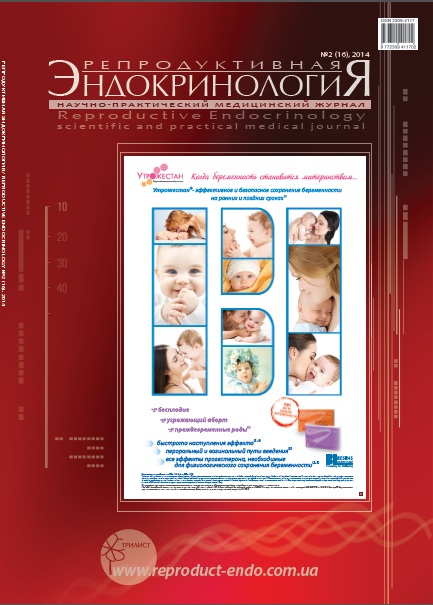Pneumonia in childbirth as a mask of postpartum cardiomyopathy in the 28 -year-old patient in the early postpartum period
DOI:
https://doi.org/10.18370/2309-4117.2014.16.92-94Keywords:
clinical case, pregnancy, perinatal cardiomyopathy, dilated cardiomyopathyAbstract
The article described a rare clinical case of perinatal cardiomyopathy as a form of dilated cardiomyopathy of unknown etiology.
Perinatal cardiomyopathy was diagnosed on the eighth day after delivery in a patient with fever and diagnosis of generalized infection (pneumonia) that masked the symptoms of heart disease. Signs of cardiomyopathy were confirmed by the ehocardiographic study on the ninth day after the delivery.
The patient was hospitalized, perinatal cardiomyopathy and pneumonia were treated, resulting in the patient’s condition improved, and there was complete resolution of pneumonia and normalization of laboratory values.
References
- Dąbrowska-Kugacka, A. «Kardiomiopatie a ciąża. In Świątecka G., Kornacewicz-Jach Z. (ed). Choroby serca u kobiet w ciąży.» VM Group, Gdańsk (2006): 118-135.
- Elkayam, U. Akhter, M.W. Singh, H. i wsp. «Pregnancy associated cardiomyopathy: clinical characteritics and a comparison between Early and late presentation.» Circulation, 111 (2005): 2050-2055.
- Mielniczuk, L.M. Darryl, D. David, B. «Estimating the true prevalence, morbidity, and mortality of peripartum cardiomyopathy.» J. Card. Faail., 10 (2004): 4 supl 4, abstr 297.
- Fett, J.D. Dowell, D.L. Carraway, R.D. Sundstrom, J.B. Ansari, A.A. «One hundred cases of peripartum cardiomyopathy … and counting: what is going on ?» Int. J. Cardiol, 97 (2004): 571-573.
- Fett, J.D. Christie, L.G. Carraway, R.D. Ansari, A.A. Sundstrom, J.B. Murphy, J.G. «Unrecognized peripartum cardiomyopathy in Haitian women.» Int. J. Gynecol. Obstet, 90 (2005): 161-166.
- Bultmann, B.D. Klingel, K. Nabauer, M. Wallwiener, D. Kandolf, R. «High prevalence of viral genomes and inflamation in peripartum cardiomyopathy.» Am. J. Obstet. Gynecol, 193 (2005): 363-365.
- Sliwa, K. Hilfiker-Kleiner, D. Petrie, MC. Mebazaa, A. Pieske, B. Buchmann, E. Regitz-Zagrosek, V. «Current state of knowledge on aetiology, diagnosis, management, and therapy of peripartum cardiomyopathy: a position statement from the Heart Failure Association of the European Society of Cardiology Working Group on peripartum cardiomyopathy.» Eur J Heart Fail, Aug;12(8) (2010): 767-78.
- Pearson, GD. Veille, JC. Rahimtoola, S. Hsia, J. Oakley, CM. Hosenpud, JD. Ansari, A. Baughman, KL. «Peripartum cardiomyopathy: National Heart, Lung, and Blood Institute and Office of Rare Diseases (National Institutes of Health) workshop recommendations and review.» JAMA, 283 (2000): 1183-1188.
- Hilfiker-Kleiner, D. Kaminski, K. Podewski, E. Bonda, T. Schaefer, A. Sliwa, K. Forster, O. et al. «A cathepsin D-cleaved 16 kDa form of prolactin mediates postpartum cardiomyopathy.» Cell, 128 (2007): 589-600.
- Fett, JD. Christie, LG. Carraway, RD. Murphy, JG. «Five-year prospective study of the incidence and prognosis of peripartum cardiomyopathy at a single institution.» Mayo Clin Proc, 80 (2005): 1602-1606.
- Sliwa, K. Forster, O. Libhaber, E. Fett, JD. Sundstrom, JB. Hilfiker-Kleiner, D. Ansari, AA. «Peripartum cardiomyopathy: inflammatory markers as predictors of outcome in 100 prospectively studied patients.» Eur Heart J, 27 (2006): 441-446.
- Hilfiker-Kleiner, D. Meyer, GP. Schieffer, E. Goldmann, B. Podewski, E. Struman, I. Fischer, P. Drexler, H. «Recovery from postpartum cardiomyopathy in 2 patients by blocking prolactin release with bromocriptine.» J Am Coll Cardiol, 50 (2007): 2354-2355.
Downloads
Published
How to Cite
Issue
Section
License
Copyright (c) 2014 A. Stochmal, T. Milewicz, M. Sajewicz, B. Rosiek-Ruszar, K. Zając, S. Mrozińska, K. Doroszewska, M. Kiałka, K. Rytlewski, R. Drwiła, A. Siekańska, Z. Chaykivska, M. Wójcik, D. Mądroszkiewicz, E. Zimmer-Satora, M. Cwynar, C. Begejowicz, J. Krzysiek

This work is licensed under a Creative Commons Attribution 4.0 International License.
Authors who publish with this journal agree to the following terms:
- Authors retain copyright and grant the journal right of first publication with the work simultaneously licensed under a Creative Commons Attribution License that allows others to share the work with an acknowledgement of the work's authorship and initial publication in this journal.
- Authors are able to enter into separate, additional contractual arrangements for the non-exclusive distribution of the journal's published version of the work (e.g., post it to an institutional repository or publish it in a book), with an acknowledgement of its initial publication in this journal.







